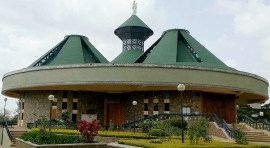From above, the cupolas of this church look like mountaintops. In Africa people are deeply religious and, in African culture, God lives in various places, usually on high mountains. This Shrine is in fact built in the district of "Upper Hill", a hill in the city of Nairobi.
By entering this church, the faithful are therefore invited "to climb the mountain of God". But the cupolas at the top of the church also resemble the huts of a house, thus expressing the communal aspect of Christians living together as God's people. The roof of these cupolas is also green, indicating life and hope. The three smaller cupolas also symbolise the three theological virtues of faith, hope and charity. The front facade of the church consists of three large cylindrical walls, which resemble the base of the three cupolas, to give the appearance of traditional huts.
Separating the cuoolas and walls is a beautifully decorated circular canopy, adorned with symbols of motherhood borrowed from the Maasai people (a tribe of Kenya), particularly the pendants of women's necklaces.
Also of great importance is the door of the Shrine, a masterpiece of visual creation, artistically unique. On it are a myriad of female images. The entire structure features six dominant images which appear devoid of human appearance and are more like masks. They contain the spirit of the Christian ancestors, the triumphant church that, together with Mary, protects and takes care of the pilgrim church. They also highlight the concept of "mother". The typical African figures carved in high reliefs and bas-reliefs and arranged in various sizes depict the different roles of a mother. The interpenetration of coloured glass on the door gives more life and light to the woodwork.
Once inside the Shrine you can see numerous crosses closely arranged and carved on the wood of the door. When we leave the Shrine the crosses on the door remind us of the invitation to follow Christ, carrying our daily crosses. They also have the appearance of a symmetry of crosses and recall the end for which man must prepare.
As soon as you enter, you can't help but notice the large mosaic that forms the backdrop to the Shrine. It is a representation of Don Bosco's Dream at Nine Years of Age, whose bicentenary is celebrated this year.
The altar of the Church is built on three African drums, which symbolise the presence of the Holy Trinity on the altar itself.
The windows of this church, in addition to bringing more light into the building, also teach something theological.
The interior is adorned with the traditional 14 Stations of the Cross. Each station is represented by a three-dimensional metal statue fixed on a wooden structure. The 14 wooden panels have a variety of designs, which have as a common motif the cowrie shell, which, in traditional African society, was used as money. Dominating all these designs is a larger cross filled with small masks, connected by small crosses, to form what looks like a rosary. All this indicates the saints who participated in the Passion of our Lord, through their exemplary life, just like Mary.
There are three works of art that adorn the Sanctuary: the crucifix, the statue of Don Bosco with Dominic Savio and the statues of the Stations of the Cross. They are made of metal, with iron plates and rods meticulously welded to form their respective shapes. The stylised representation of Jesus on the cross brings out all the agony and suffering of Jesus.
Moving to the other side of the Sanctuary, there is the statue of Don Bosco with St Dominic Savio. On the occasion of the Bicentenary of the birth of Don Bosco, between 2009 and 2015, three replicas of the statue of Saint John Bosco were made, which contains some bones of his right arm. These three works were taken on pilgrimage around the world, in over a hundred countries, including Kenya, in 2011. One of these statues has found its place in the Shrine of Mary Help of Christians.
Finally, going down the stairs adorned with paintings depicting the life of St John Bosco, you reach the crypt chapel.
This church is a centre of pilgrimage not only in Kenya, but throughout East Africa. It is not just a building, but a construction created to share the faith in the Catholic tradition and to deepen it through catechesis.



